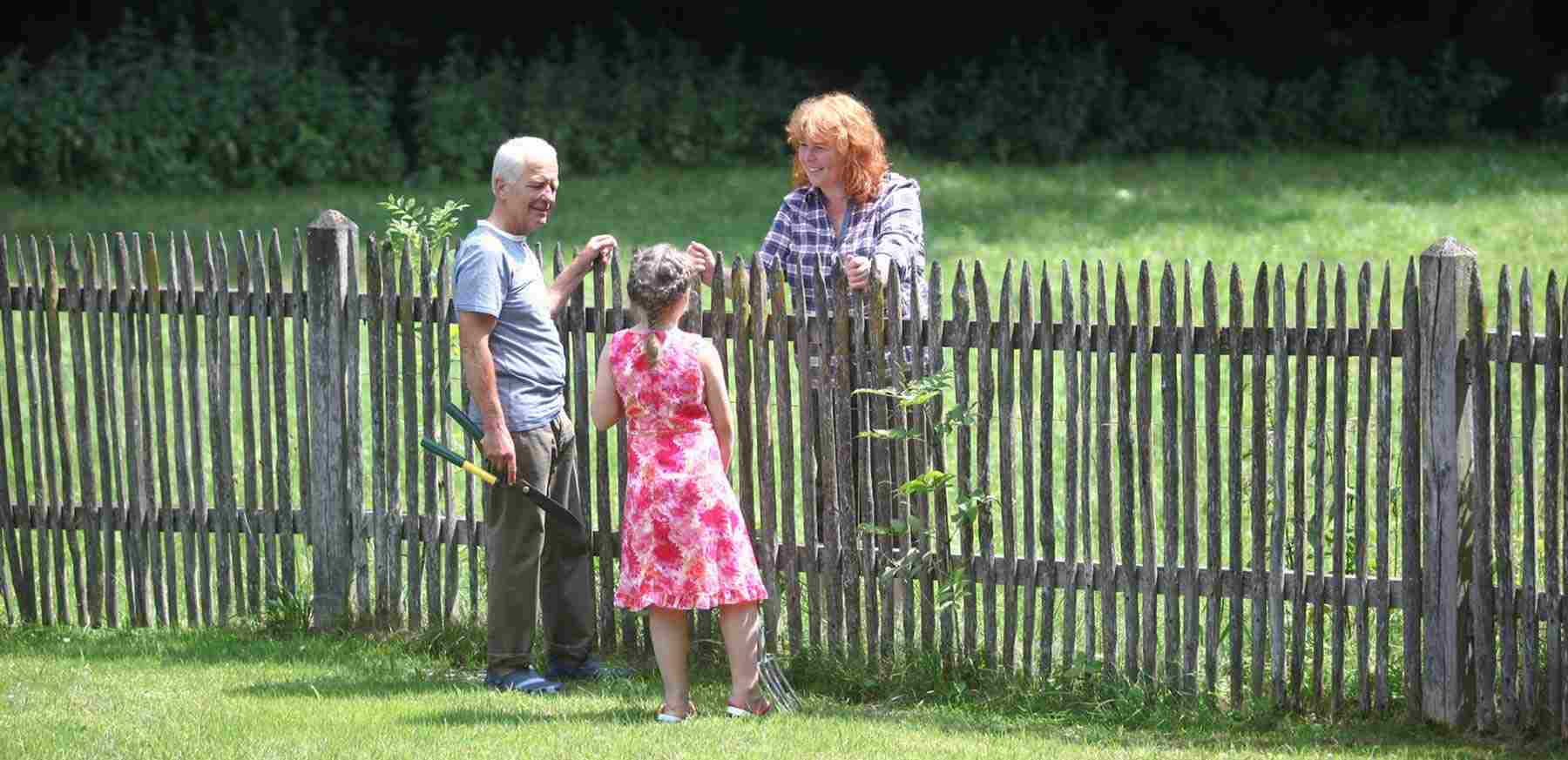For years Beth Warner and her husband, Steve, dreamed of buying a tract of land to share with the families of some of their closest friends. They had visions of shared equipment and multiple sets of hands pitching in when it came time to harvest.
“When a neighbor decided to sell his home and 30 acres, we decided to pursue the dream in our own backyard,” says Beth. The Warners’ house was on a 9.5-acre tract adjacent to the Athens, Georgia, property.
The Warners worked out a deal with the neighbor to divide his land and recruited some friends and former colleagues. “One friend bought the house and 14 acres, another bought 5 acres on which to build their home, and we bought the 11 acres in-between,” says Beth.
Just shy of five years in, the arrangement is working well. Beth and Steve raise sheep and were able to expand their flock thanks to the extra pastureland. The five adults who live on the multifamily compound all work together on big chores like planting gardens, chopping firewood, and canning. They’re even considering launching honey and cut flower businesses.
It’s an idyllic idea: groups of friends or relatives breaking bread, raising children, and just doing life together. As the Warners found, it can be a reality. But successful communal living doesn’t just happen; it takes planning and communication.
Thinking about building your own family compound? Read on for our top tips on how to get started.
Plan to Succeed
1. Clearly Identify Your Objectives
As a land broker with Southeastern Properties, Jonathan Goode has a fair amount of experience helping clients find land for family compounds. He also lived on one, himself, for about 10 years.“The first thing I would tell people is they need to identify their objectives,” he says.
Whether you’re looking to establish a sustainable farm community, a family hunting property, a joint business venture, or just a place to gather to live life together, having big picture conversations up-front is priority one.
The Warners and their friends held multiple brainstorming sessions before committing to their property purchase. They encouraged each other to dream big about what the property could be and made flip board sheets detailing their goals for the property, what each hoped to get out of the arrangement, and what they could offer the group.
2. Do Your Research
While brainstorming sessions are a great way to solidify a vision for the property, it’s also a good idea to see how others are making family compound living work.The Warners went to visit some intentional communities in the surrounding areas. While they weren’t interested in income sharing, they did want to learn about how others were navigating life on adjoining land with some shared resources.
“Every encounter taught us something, even if it was what we did not want,” says Beth.
The Warners found being able to speak directly to people living in intentional communities, whether with relatives or friends, was an invaluable way to understand what would work best for them.
3. Begin With the End in Mind
Change is inevitable. Whatever the reason—divorce, marriage, job loss, a falling out, or even death—the structure of the family or friend group is bound to evolve over time. For this reason, one of the most important things for would-be compound dwellers to do in the early-stages, says Goode, is to make an exit strategy part of the plan right off the bat. “Begin with the end in mind,” he says. “How do we get out of this situation if we need to? Try to divide a property or piece it together in such a way that the removal of one piece does not diminish the value of the overall property and the enjoyment of the people there for communal purposes.”
4. Don’t Neglect the Logistics
Families or close groups of friends may balk at in-depth discussions of personal finances or having to get everything down in writing when entering into a community living arrangement. But co-ownership of something as fundamental as a home or land often requires more than a simple handshake agreement.“Very few families or groups of people all have access to the exact same resources,” says Goode. “How is that going to be structured? Is every member going to contribute an equal part? Is there going to be one main benefactor? How is the land going to be purchased?”
It’s always a good idea to seek professional legal counsel in situations where there is co-ownership of property or big-ticket items like farming equipment. In an article on its site, The Fellowship for Intentional Communities lays out a compelling argument for setting up a legal structure before combining assets.
“If it does not have a legal structure, problems can arise with regard to property rights for new members, compensation for departing members, personal liability, holding title to property and assets, or community agreements. Legal structures provide, if not a solution, at least a means to resolve problems fairly and equitably.”
Find Your Land
Finding the right parcel of land for your multi-family compound starts with understanding how you’ll use the property, and what each member needs to successfully and happily live there for years to come.To ensure one property will work for every member of the community, start by asking the following questions:
- Does the land need to be in a specific location or close to a specific town for employment or healthcare purposes?
- Will the property be used for a business, like farming or livestock?
- What are the must-haves on the property—such as open land for farming or pasture, timber, or a lake?
In the Warners’ case, when the property next door became available, it turned out to be the perfect situation for all three families involved.
“Much of the new land was already in pasture and neither of our friends wanted to raise livestock or maintain the pastures,” says Beth. “We put in fencing and now graze our sheep on their land. Our friends enjoy the view and the healthier pasture, have increased land value and security with the improved fencing, and occasionally help with moving the sheep and other related chores.”
The property is close enough to make commuting possible for Cheryl, who lives on the 14-acre plot. It’s also ideal for retired couple Linda and Perry, who enjoy having their grandchildren out to experience farm life.
If you plan for each member family to own their own home and the parcel of land on which it is built, Goode recommends speaking to a land lender about how to structure a sale—whether that means seeking out adjoining tracts or dividing up a larger parcel.
It’s even more important to work closely with a land lender and attorney if you decide to communally own property or build multiple structures on a single parcel of land.
“They need to find out from their county or local municipality what the regulations are,” says Goode. “Some counties have very strict subdivision laws for 40 acres or smaller regarding how many times a parcel can be divided or how many structures can be built without having a subdivision plan.”
Tip: If you're looking for rural acreage, our parent company, Raydient Places + Properties, offers large tracts in several states in the U.S. South. Search available properties in Florida, Georgia, Alabama and Texas here.

Navigating Life on Shared Land
The majority of people seeking out intentional communities or communal land do so out of a shared sense of purpose or a common desire to live life together. The Warners have found real joy in having neighbors who drop in with homemade pie or help chop firewood for a friend in need. They look out for one another and break bread together. There are mornings when Beth will go out to work with the sheep, and her neighbor, Linda, will come up to the fence line with a cup of coffee. Or, when Linda’s husband, Perry, who suffers from early onset dementia, needs to get out, Beth’s husband, Steve, may take him to the movies, giving Linda some time in the house alone. It’s a vision of community living that isn’t necessarily a given in a traditional neighborhood setting.“Good neighbors can do that,” says Beth, “but I just don’t see a lot of evidence of that.”
These deep ties and mutual respect for one another—along with careful planning upfront—have made the Warners’ multi-family homestead successful. But, as with any group, related or not, there are bound to be conflicts.
Working through differences without creating rifts or resentment starts with clearly-defined expectations and open communication. Keep these tips in mind to manage conflict on your compound:
1. Anticipate Conflict
If you talk about potential problems before they arise, you won’t be surprised when they do. Discuss your expectations about issues like who will maintain the grass and the roads; who is allowed to use the lake or hunting land and when; whether a gate will be left open or closed; and how shared spaces will be used and maintained.It may seem like minutiae, but “very few people agree on how a matter should be handled,” says Goode. “If you’re in frequent communication with one another in addressing these kinds of issues it prevents things from building up.”
2. Give Each Other the Benefit of the Doubt
Trust and mutual respect go a long way toward harmonious compound living. It’s what Beth calls a “reservoir of goodwill.”“If you’ve got a clear goal of the dream—the vision—then when conflicts happen, rather than just focusing on that, you are able to put it in context. Ask ‘How do we resolve it or work around it so it doesn’t take us away from our dream or the lifestyle we’re working toward?’” she says. “I can have a disagreement with any one of them but if I have a reservoir of goodwill, I know what their hearts are like, and this is just a bump in the road and we move on.”
3. Enjoy!
Amid all the logistics it’s easy to lose site of why you’re planning a multi-family compound: Having access to shared resources, including time, labor and creativity; being able to dream big, plan and execute on your own property; and simply enjoying the company of the people you care about.“It can be a lot of fun because you have all your loved ones in one spot,” says Goode. “There a lot of positives. When it works well, it works very well.”
Further reading: What it’s Like to Live on a Family Compound


























